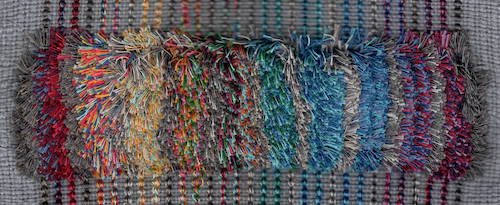
What’s that Sound?
A few weeks ago I posted a story about an experience in which I attempted to weave a double-width throw using mohair bouclé as my warp. Challenging and time-consuming though it was, it did end up with a happy ending and a lovely throw. Apparently this struck a chord with some of you because I received a number of email responses from weavers sharing their own “learning experience” stories with me. It occurred to me…

The Whirled Wide Web
I’m not always entirely thrilled with having to spend so much of my life in a digital world, but if I were asked what my favorite thing about it is, I would say that without question it’s the ability to look up just about anything imaginable and find what you are looking for. In grade school I spent many long hours at the library looking through the World Book Encyclopedia…

Double, double, toil and trouble
When I am teaching doubleweave I generally use perle cotton as the standard yarn. It has lots of great qualities for doubleweave - it’s strong and smooth, is widely available and reasonably affordable, and it comes in a wide range of beautiful colors. Students often ask whether other types of fibers can be used for doubleweave. My answer is yes, of course. Any type of fiber can be used, but there are two important qualities…

Loom with a View
It was the summer of 1990. My former husband and I had been living in Santa Barbara, California for the past eight years. He started out going to the university to work on a master’s degree, and ended up working there in the Physics department. I worked at an assortment of jobs during those years, but also worked on honing my weaving skills while participating in various shows and galleries. In many ways it was…

"How I Got Into Weaving"
If you don’t already know Stacey Harvey-Brown you will want to meet her next time you have the opportunity. Stacey is a British weaver who has been teaching for the past sixteen years in the UK, and now teaches from her new studio in the south of France. As you can probably tell from the photograph, Stacey is a very fun person who is full of lots of creative energy. Besides being a master weaver,…

I Love Hue Too! II
A couple months ago I wrote a blog post about working with various color apps to develop a finer-tuned sense of color nuances - https://doubleweaver.com/i-love-hue-too/. One of these apps, I Love Hue, has become a particular favorite of mine. As you work your way through solving the color grids you advance in levels of difficulty. At the time that I wrote the previous post I was working with fairly complex rectangular grids, and it’s fun…

From the Ridiculous to the Sublime
After sixteen months of being sequestered at home and only seeing people with masks on their faces, this past month has been a whirlwind of activity. Santa Fe is filled with tourists once again, and our summer festivals are back, even if at a reduced scale. It never rains, but it pours. In addition to teaching two overlapping workshops on zoom, I also had two overlapping sets of old friends come into town. I was…

Tying One On, part 3
In 2010 the first edition of my book, The Weaver’s Studio: Doubleweave, and a couple instructional videos were released by Interweave Press. In those videos I wore one of my handwoven scarves tied in a particular way that looks like a braided knot. As soon as the videos were released Interweave started getting calls and emails with questions. Were the questions about doubleweave? No - people wanted to know how I tied my scarf. Since…

Tying One On, part 2
In my last blog post I showed you the method that I use for attaching my warp sections to the warp beam of my looms for back-to-front warping. In that post I mentioned that I have tried many different methods over the years and have only recently come to the way that I am currently using. By contrast, I came across the system that I use for tying my warp on to the front apron…

Tying One On, part 1
I’ve been weaving for somewhere in the vicinity of 40 years, and you might think that I would have everything down to a science by now. But one aspect of weaving that I’ve always been looking for a better way to do is attaching and winding the warp on to the warp beam. I’m a pretty confirmed back-to-front warper and really like having uncut loops that are keeping my warp firmly attached at the back…
